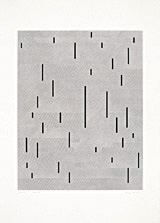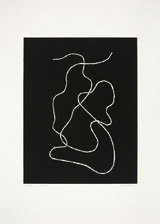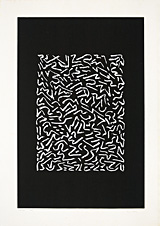| Anni
Albers was born in Berlin in 1899. She studied art first with Martin Brandenburg
in Berlin and then for a year at the Kunstgewerbeschule in Hamburg. In
1922 she entered the Bauhaus at Weimar to study weaving. She completed
her course at the Bauhaus at Dessau in 1929 and taught there, in the fabrics’
section, from 1930 to 1933 when, the Bauhaus having been closed by the
Nazi regime, she emigrated to the United States with her husband, Josef
Albers, and accepted an assistant professorship at Black Mountain College
in North Carolina. In 1937 she became an American citizen.
The importance of
the work of Anni Albers, especially in the field of graphics, did not
fail to be recognized. She has received prizes, medals and diplomas as
well as no less than four degrees honoris causa from American universities.
Of the numerous exhibitions of her work, the most important were at: Museum
of Modern Art, New York (1949); Wadsworth Atheneum, Hartford (1953); Honolulu
Academy of Arts (1954); |
|
Massachusetts
Institute of Technology (1959); Carnegie Institute, Pittsburgh (1959);
Baltimore Museum of Art (1959); Yale University Art Gallery, New Haven
(1959); Colorado Springs Fine Arts Center (1959); Contemporary Arts Museum,
Houston (1960); University of Bridgeport (1971); Kunstmuseum der Stadt,
Düsseldorf (1975); Bauhaus-Archivs, Berlin (1975); Brooklyn Museum,
New York (1977); Queens College Library, New York (1979); Monmouth Museum
(1979); Hartford Art School (1979); Mattatuck Museum, Waterbury (1979);
Graphic works by Anni Albers are to be found at European and American
museums: Art Gallery of Ontario; The Center for Graphic Arts, University
of California, Los Angeles; The Israel Museum, Jerusalem; Kunst museum
der Stadt, Düsseldorf; Metropolitan Museum, New York; Museum of Modern
Art, New York; St. Louis Art Museum; Seattle Art Museum; Wadsworth Atheneum,
Hartford; Westfälisches Landesmuseum für Kunst und Kunstgeschichte,
Munster; Yale University Art Gallery, New Haven; National Gallery, Washington.
(Fausta
Squatriti, Connections 1925/1983, introduction page)
|











